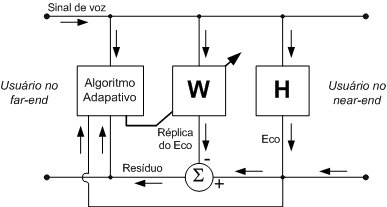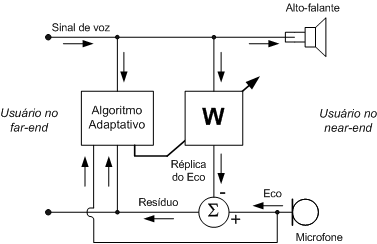Adaptive Filtering and Echo CancellationSince 1994, LINSE has carried out a great deal of research on adaptive filtering and its applications, among them we highlight echo cancelers. As a result, some echo canceler versions have been developed and used in different applications, such as public switched telephone networks (PSTN), voice over IP (VoIP), and hands-free telephones.
The hybrid echo in PSTNs is caused by the four-wire to two-wire impedance mismatch. This mismatch results in unwanted reflection of the speech signal back to the speaker (echo). In order to minimize this unwanted echo, a line echo canceler is used.
In short-distance calls, echo is unnoticeable, since the amount of time necessary for the voice signal to return to its point of origin is short. On the other hand, for calls with a significant delay in voice return, such as international calls via satellite and voice over IP systems, a fraction of the voice signal which returns is noticed by the user as an uncomfortable echo, making conversations difficult. In this case, the use of a line echo canceler (LEC) is required.
Figure 1 shows the block diagram of a line echo canceler system, considering a telephone call between the far-end and near-end users. 
Figure 1: Echo cancellation system. This figure shows only the echo generated by the far-end user. Block H represents the hybrid impulse response of the echo path. The echo canceler, which is represented by a digital filter W along with an adaptive algorithm, aims to modify the digital filter W response, so as to identify (estimate) the system H.
LINSE research in adaptive filtering includes several types of algorithms. Among them, NLMS, Leaky NLMS, Proportional NLMS, FxLMS and VSSVLFxLMS (the latter is LINSE's original contribution).
The performance of the line echo canceler developed by LINSE can be checked in the samples below.
 | Audio sample containing the voice signal from the near-end user, the user's voice signal in the far end, and the echo of the user's voice in the far end. |
 | Audio sample showing the LEC action, containing the voice signal from the near-end user and the user's voice signal in the far end. |
Nowadays, another application which has been growing in importance, in applied research at LINSE, is the control of acoustic echo in hands-free systems. This type of echo occurs due to the acoustic coupling between the loudspeaker and the microphone. In a first approach, such an echo was treated by suppressing transmission in one of the sides (half-duplex communication). This technique, although almost eliminating echo completely, has the disadvantage of reducing the fluency and naturalness of the conversation. This way, the use of an acoustic echo canceler (AEC) can be seen as a more efficient solution, allowing an effective echo control without disturbing the quality of the conversation.
Figure 2 illustrates a system of acoustic cancellation, in which the user at the near end makes use of a hands-free telephone. 
Figure 2: Acoustic echo cancellation system. In this case, the voice signal of the far-end user is reproduced by the loudspeaker of the telephone and runs through the air by one (or several) way(s) until the microphone, where it is captured. In a way very similar to the LEC, the adaptive filtering algorithm seeks to adjust the filter response W aiming to obtain a model of the acoustic path traveled by the voice signal.
An example of the application of the AEC can be checked in the audio files below.
 | Sample of the audio containing the voice signal of the user at the near end, and the voice signal and its corresponding acoustic echo from the far-end user, reproduced by the loudspeaker. |
 | Audio sample after the action of the AEC, containing the voice signal of the user at the near end, and the voice signal from the far-end user, reproduced by the loudspeaker. |
|















